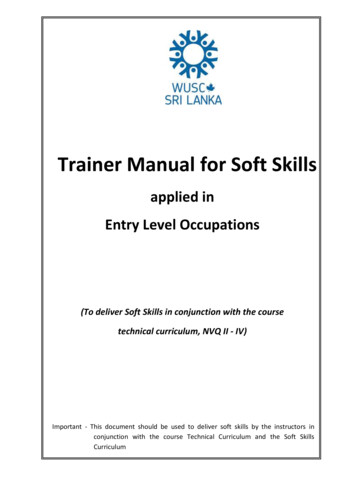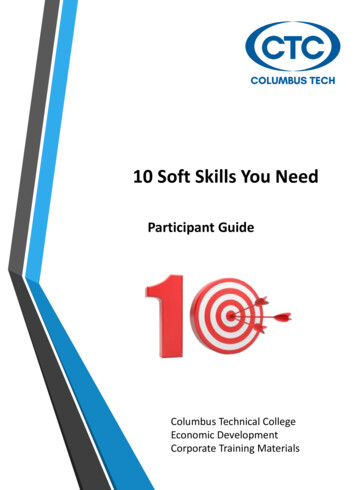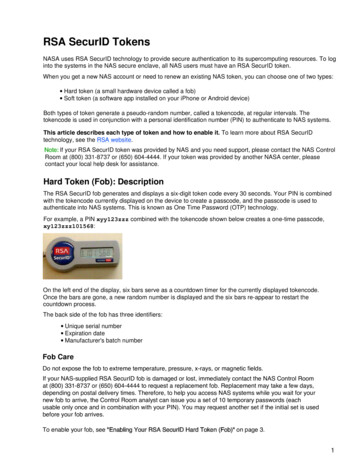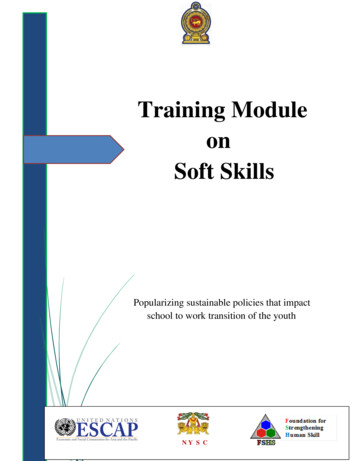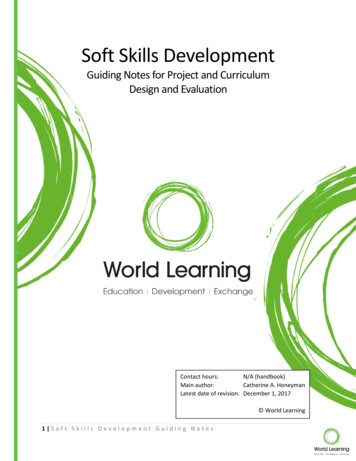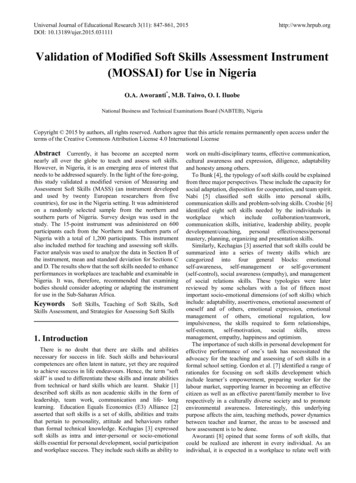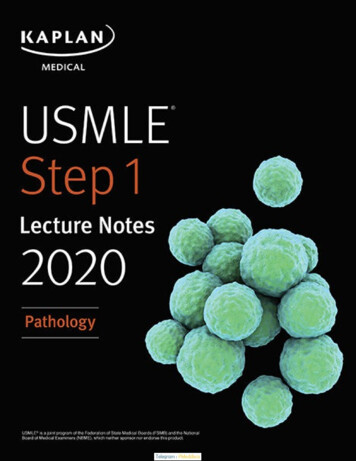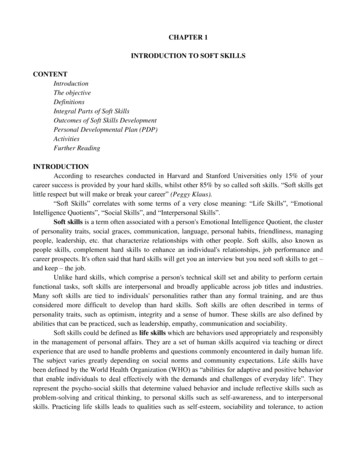
Transcription
CHAPTER 1INTRODUCTION TO SOFT SKILLSCONTENTIntroductionThe objectiveDefinitionsIntegral Parts of Soft SkillsOutcomes of Soft Skills DevelopmentPersonal Developmental Plan (PDP)ActivitiesFurther ReadingINTRODUCTIONAccording to researches conducted in Harvard and Stanford Universities only 15% of yourcareer success is provided by your hard skills, whilst other 85% by so called soft skills. “Soft skills getlittle respect but will make or break your career” (Peggy Klaus).“Soft Skills” correlates with some terms of a very close meaning: “Life Skills”, “EmotionalIntelligence Quotients”, “Social Skills”, and “Interpersonal Skills”.Soft skills is a term often associated with a person's Emotional Intelligence Quotient, the clusterof personality traits, social graces, communication, language, personal habits, friendliness, managingpeople, leadership, etc. that characterize relationships with other people. Soft skills, also known aspeople skills, complement hard skills to enhance an individual's relationships, job performance andcareer prospects. It's often said that hard skills will get you an interview but you need soft skills to get –and keep – the job.Unlike hard skills, which comprise a person's technical skill set and ability to perform certainfunctional tasks, soft skills are interpersonal and broadly applicable across job titles and industries.Many soft skills are tied to individuals' personalities rather than any formal training, and are thusconsidered more difficult to develop than hard skills. Soft skills are often described in terms ofpersonality traits, such as optimism, integrity and a sense of humor. These skills are also defined byabilities that can be practiced, such as leadership, empathy, communication and sociability.Soft skills could be defined as life skills which are behaviors used appropriately and responsiblyin the management of personal affairs. They are a set of human skills acquired via teaching or directexperience that are used to handle problems and questions commonly encountered in daily human life.The subject varies greatly depending on social norms and community expectations. Life skills havebeen defined by the World Health Organization (WHO) as “abilities for adaptive and positive behaviorthat enable individuals to deal effectively with the demands and challenges of everyday life”. Theyrepresent the psycho-social skills that determine valued behavior and include reflective skills such asproblem-solving and critical thinking, to personal skills such as self-awareness, and to interpersonalskills. Practicing life skills leads to qualities such as self-esteem, sociability and tolerance, to action
competencies to take action and generate change, and to capabilities to have the freedom to decidewhat to do and who to be.Life Skills-Based Education has a long history of supporting human development. Life skillsbased education is now recognized as a methodology to address a variety of issues of youthdevelopment and thematic responses including as expressed in World Youth Report (2003), WorldProgram for Human Rights Education (2004), UN Decade on Education for Sustainable Development(2005), the World Development Report (2007), and so on. Expected learning outcomes include acombination of knowledge, values, attitudes and skills with a particular emphasis on those skills thatrelated to critical thinking and problem solving, self-management and communication and interpersonal skills.Social skills are any skills facilitating interaction and communication with others. Social rulesand relations are created, communicated, and changed in verbal and nonverbal ways. The process oflearning these skills is called socialization.Interpersonal skills are sometimes also referred to as people skills or communication skills.Interpersonal skills are the skills a person uses to communicate and interact with others. They includepersuasion, active listening, delegation, and leadership. The term “interpersonal skills” is used often inbusiness contexts to refer to the measure of a person's ability to operate within business organizationsthrough social communication and interactions. Interpersonal skills are how people relate to oneanother.WHY SOFT SKILLS?Self An awareness of the characteristics that define the person one is and wants to become.Opportunity An awareness of the possibilities that exist, the demands they make and the rewards andsatisfactions they offer.Aspirations The ability to make realistic choices and plans based on sound information and on self–opportunity alignment.Results The ability to review outcomes, plan and take action to implement decisions andaspirations, especially at points of transition (Kumar, A., 2007).In order to SOAR students need two things:Academic Roots– Discipline based knowledge and understandingAcademic Wings– The ability to enhance that knowledge and understanding with awareness (self andothers), critical thinking, reflective practice.The specificity of Soft Skills Discipline specific Placement / employability preparation Lifelong learners– Learning how to learn
– Reflective practitionersFig. 1. Soft SkillsSoft skills focus more on people than processes. Today‟s service economy and ascendance ofwork teams in large organizations puts a new premium on people skills and relationship-building(Kocon, L.).Soft skills People skills Street SmartsTHE LEARNING OBJECTIVES:The module content is centered on students‟ learning and development. It seeks to motivatestudents by helping them to be more effective, independent and confident self-directed learners byimproving their capacity to understand what they have learned, how and when they are learning, and toencourage them to monitor, reflect on, evaluate, plan and take responsibility for their own learning.The Main tasks of the Soft Skills module are to develop and enhance: Critical and reflective thinking; Self-management and self awareness skills; Communication skills, including interpretation and use of feedback; Team working and peer support strategies.DEFINITIONS“What exactly are soft skills?” This basic question is not easy to answer, because the perceptionof what is a soft skill differs from context to context. A subject may be considered a soft skill in oneparticular area, and may be considered a hard skill in another. On top of it the understanding of whatshould be recognized as a soft skill varies widely.Generally, soft skills may be subdivided into three basic categories:
1. Personal qualities2. Interpersonal skills3. Additional skills/knowledgeSoft Skills:Critical thinkingCommunication SkillsListening to othersReflective PracticeGroup Work / working with othersCV and ApplicationsSelf assessmentProfessional practiceAssertivenessCreative problem solvingMentoring and peer supportInformation LiteracyDigital LiteracyPortfolio management(tools for delivery, recording and reflection)Soft skills complement hard skills to enhance an individual's relationships, job performance andcareer prospects. Unlike hard skills, which tend to be specific to a certain type of task or activity, softskills are broadly applicable.While your technical skills may get your foot in the door, your people skills are what open mostof the doors to come. Your work ethic, your attitude, your communication skills, your emotionalintelligence and a whole host of other personal attributes are the soft skills that are crucial for careersuccess.Soft skills are often broken down into categories, or types of skills according to the level ofcomplexity and interaction. An example of one way of categorizing social skills can be found in thetable below:Table 1.Soft Skills CategorizingSkill SetUsed forExamplesAbility to maintain eye contact, maintainappropriate personal space, understand gesturesand facial expressionsFoundation SkillsBasic social interactionInteraction SkillsResolving conflicts, taking turns, learning how toSkills needed to interact with begin and end conversations, determiningothersappropriate topics for conversation, interactingwith authority figuresAffective SkillsSkills needed forunderstanding oneself andothersIdentifying one's feelings, recognizing the feelingsof others, demonstrating empathy, decoding bodylanguage and facial expressions, determiningwhether someone is trustworthyCognitive SkillsSkills needed to maintainmore complex socialinteractionsSocial perception, making choices, selfmonitoring, understanding community norms,determining appropriate behavior for differentsocial situations.(Canney and Byrne, 2006)
Fig. 2. Soft Skills DifferentiationFig. 3. Soft Skills and OutcomesSelf-awareness includes identifying knowledge gaps, taking responsibility for own learning anddevelopment, understanding the impacts of self-efficacy, dealing with pressures and emotions,reflective practice, professional development and current awareness.
The mentioned skills assist students in understanding the learning process and constructing theirown Selves in academic and professional activities. They become apparent in Surface / deep / strategic learning Self-efficacy Requires reconstruction of known events in their own lives Constructing a self-MAP Motivation Ability PersonalityINTEGRAL PARTS OF SOFT SKILLSI. Self-Management System consists of Self-motivation, taking responsibility, tasksetting/prioritizing, time-management. The structure of Self-Management System is detected in theTable below.Fig. 4. Self-Management Structure
II. Critical Thinking: «thinking about thinking» (Raiskums, B. W.) «this way of thinking, which does not accept the arguments and conclusions blindly, rather,it examines assumptions, recognize hidden values, evaluates the data and conclusions» (Mayers, D.) «reasonable reflective thinking, aimed at deciding what to trust and what to do» (Ennis, R.) “An expert is a man (woman) who has made all of the mistakes which can be made in avery narrow field” (Bohr, N.) “Imagination is more important than knowledge” (Einstein, A.) Critical thinking is the ability to question and to cope with uncertainty, without which noneof the above would be possible.Critical Thinking Characteristics include logic; imagination; risk; “accepting nothing,questioning everything”, reaching your own conclusion; being prepared to change that conclusion inthe light of emerging evidence; “The world was flat until we discovered it wasn‟t.at the minute webelieve it‟s a sphere.”.Example of Critical Thinking: Experimentation (lab / hypothesis testing) Social research Data interpretation and explanation Creative problem solving Identify the issue Come up with alternative solutions Learning to cope with uncertainty and embracing it as a learning tool (Pickard, A., 2010).III. Reflection is a form of thinking used to fulfill a purpose or to achieve some anticipatedoutcome and is largely based on the further processing of knowledge and understanding that we alreadypossess.Fig. 5. Reflective Practice Circle
Reflective Practice is triggered with the help of Self assessment questions: What am I trying to do exactly? Why am I doing it? What went well and why? What went less well and why? How could I do better next time? (Shenton, A., 2012)Fig. 6. Reflective Practice (Kolb, 1984; Carr & Kemmis, 1986)Another scheme of reflective practice consists of 1) the reflective diary; 2) description;3) interpretation; 4) outcome which involves hard systematic thinking and soft insight, intuition andtacit knowledge leading to a plan of action based on critical evaluation of all the available evidence.IV. Communication and InteractionFig. 7. Effective Communication
Effective communication provides for high level of presentation skills: to increase both skills and confidence levels to improve research, design and communication skills to develop team working and project management skills to strengthen learning and enthusiasm for further knowledge to promote critical and analytical thinkingacademic debates: Content and formats of academic debate Listening skills Giving and receiving feedback Reacting to grounded criticismand effective writing and listening:Fig. 8. Skillful WritingSkillful writing examples:– Technical Writing– Script writing / audience analysis / performance / reflection– Observation (self and others)– Press release; Same incident from multiple stakeholder perspectives– Sign language qualifications (Strachan, R., 2010)
Listening to OthersFig. 9. Listening to OthersThe examples of effective listening include: Role play Sender / receiver Same audience, same message, how many interpretations? Constructed conversationsV. Group work is one of the most useful ways of learning about cooperation, sharedresponsibility, project planning, and time management. Learning how to work successfully in a grouphas a close association with how we participate in the work place and includes: Social responsibility Using logical and rational arguments to persuade others Identifying the needs of others and building positive relationships Understanding group dynamics Understanding yourself in relation to others and how they might perceive you. Reflection on the image you portray
Fig. 10. Group Work Productive SkillsVI. AssertivenessAssertiveness means “confident behaviour” and “self-confidence”. It is an individual ability toadvance and come true own aims, needs, wishes, claims, interest and feelings. Phenomenon ofassertiveness presupposes an existence of: a) subjective attitude toward Self (self-allowance to have theown claims); b) social readiness and ability to realize it in adequate manner (to have the own claimsand achieve their realization); c) freedom from social fear and inhibition (ability to register and revealown claims).Fig. 11. Assertive Behavior
Assertiveness training helps to: recognise the three main categories of behaviours, advantages and disadvantages and howto respond to them explore strategies for assertiveness and influence understand and use the „Assertiveness Model‟ for greater effectiveness develop and enhance self confidence and self esteem create an action plan to move forward with assertiveness skillsIn order to develop assertive behaviour we need to explore how to: Create boundaries and say „No‟ Deal with disagreement, conflict and aggressive behaviour Negotiate win-win solutions Use assertiveness techniques and strategies in a variety of work settingsVII. Peer-to-Peer is an interaction and learning method (technology) when the source ofknowledge is not a professor but a peer student (peer instructor). It promotes participation andinteraction. Peer-to-Peer activity includes both trainers and trainees into campus life and promotes asense of belonging that combats the anonymity and isolation many students experience at largeuniversities during the first year of study.Mentoring Developed their personal and professional skills such as leadership, team working,organising, time management, listening, interpersonal communication, facilitation and presentationskills Enabled them to gain confidence especially in situations when teamwork is required toattain a goal Provided valuable experience to enhance their CVs Enabled them to revise and practise their subject, and gain a deeper understanding of it(Pickard, 2008). Not just doing the evaluating but also actively engaged Mentoring at point of need Evidence of strong success rate Number of models: Mentoring (PAL‟s) Learning Leaders Student ambassadorsOUTCOMES OF SOFT SKILLS DEVELOPMENTOral communication skillsStudents are able to communicate confidently and effectively with a range of audiences, in avariety of modes or registers and settings, including persuasion, argument and exposition, and they areable to make use of different support tools, including visual, audio-visual and technological.Interpersonal SkillsStudents have the skills to be able to work effectively with a range of people in a range ofdifferent contexts, including teams, where they can be effective members and, if required, leaders,
including organizing team roles and activities. Students are open to the ideas of others. Students arecapable of listening and understanding in a range of contexts.Problem Solving SkillsStudents are able to identify and define problems and through the use of skills of analysis andcritical evaluation plan an appropriate course of action and devise solutions. Students are able to makejudgments concerning different possible solutions. They will be able to make use of creative and lateralthinking.Organizational SkillsStudents are able to set priorities, and anticipate potential problems or needs. They are able toset and achieve targets in relation to both study and workplace tasks. Students are able to manage theirtime effectively.With these soft skills you can excel as a leader. Problem solving, delegating, motivating, andteam building are all much easier if you have good soft skills.PERSONAL DEVELOPMENTAL PLAN (PDP)Personal Development Plan is a form of summative assessment.What is PDP? It is „a structured and supported process undertaken by an individual to reflectupon their own learning, performance and/or achievement and to plan for their personal, educationaland career development‟.The primary objective for PDP is to improve the capacity of individuals to understand what andhow they are learning, and to review, plan, and take responsibility for their own learning, helpingstudents: become more effective, independent and confident self-directed learners; understand how they are learning and relate their learning to a wider context; improve their general skills for study and career management; articulate personal goals and evaluate progress towards their achievement; and encourage a positive attitude to learning throughout life.PDP Structure: What are my development objectives? Priority What activities do I need to undertake to achieve my objectives? What support/resources do I need to achieve my objectives? Target date for achieving my objectives Actual date for achieving my objectivesTable 2.Benefits of Personal Developmental PlanBenefits for StudentsBenefits for StaffA structured, systematic framework forrecording, and reflecting on, all aspects oftheir HE experienceDrawing together different aspects of theirdegree programmeA framework for encouraging, and enabling,greater independent learningA structure for tracking student progress,identifying and addressing areas of concern
Scope for including extra-curricular activitiesStudent retentionIdentifying, and addressing, areas of strengthand weaknessImproving performance on assessed workStudent achievementJob seekingIdentifying and developing skills valued byemployersEvidence for use in job applications,interviews etcMore and better information for preparing studentreferencesA systematic approachDrawing together, and making explicit, existinggood practicesUseful evidence for (e.g.) institutional audit addressing HE agendas (progress files,„student success‟, employability)Skills for continuing professional development(CPD)Feeling good about achievementsMotivating Staff: Ensure that it „fits‟ with existing practices & priorities E.g. personal/guidance tutor system – avoid duplication of work Use to support student retention & achievement A reflective approach is something that we already use and value PDP need not be something „different‟ or „extra‟ „Lifelong learning‟ approachMotivating Students: Ensure that we communicate (explicitly) the potential benefits of PDP Lead by example! – if staff value PDP, so will students Recognize their efforts (accreditation?) Emphasize link with employability Employers value graduates who are reflective, and capable of managing their ownlearning, personal & professional development.PDP skills set insight, perception, Self-evaluation, and awareness and lead to autonomy andhigh levels of self-efficacy.LONGITUDINAL EVIDENCEA study on 1979 Harvard MBA students asked them: “Have you set clear, written goals for your futureand made plans to accomplish them?” Only 3% of the graduates had written goals and plans; 13% hadnon-written goals and 84% had no specific goals at all.TEN YEARS LATER they were interviewed again.1. The 13% of the class who had goals were earning, on average, twice as much as the 84% whohad no goals.2. The 3% who had clear, written goals were earning, on average, ten times as much as the other97% put together.You could say they were so focused that would have happened anyway but it‟s impossible to separatethe behavior from the output. One assumption of PDPs is that we can all „learn‟ to be focused.
What they don’t teach you in the Harvard Business Schoolby Mark McCormackACTIVITIESLearning styles questionnaire (P. Honey, A. Mumford)This questionnaire is designed to find out your preferred learning style(s). Over the years youhave probably developed learning „habits‟ that help you benefit more from some experiences than fromothers. There is no time limit to this questionnaire. The accuracy of the results depends on how honestyou can be. There are no right or wrong answers. If you agree more than you disagree with thestatement, put a tick against the appropriate number on the score sheet. If you disagree more than youagree, put a cross against the appropriate number on the score sheet. Be sure to mark each item witheither a tick or cross.Learning styles description
ctivists are those people who learn bydoing. Activists need to get their hands dirty,to dive in with both feet first. Have an openminded approach to learning, involvingthemselves fully and without bias in newexperiences. brainstormingproblem solvinggroup e learners like to understand the theorybehind the actions. They need models,concepts and facts in order to engage in thelearning process. Prefer to analyze andsynthesize, drawing new information into asystematic and logical 'theory'. applying theories ReflectorPragmatistThese people learn by observing and thinkingabout what happened. They may avoidleaping in and prefer to watch from thesidelines. Prefer to stand back and viewexperiences from a number of differentperspectives, collecting data and taking thetime to work towards an appropriateconclusion. These people need to be able to see how toput the learning into practice in the realworld. Abstract concepts and games are oflimited use unless they can see a way to putthe ideas into action in their lives.Experimenters, trying out new ideas, theoriesand techniques to see if they work. paired discussionsself e outobserving activitiesfeedback from otherscoachinginterviewstime to think abouthow to apply learningin realitycase studiesproblem solvingdiscussionFURTHER READINGBiggs, J. & Tang, C. (2007) Teaching for Quality Learning at University: What the Student Does. (3rdedition). Maidenhead: Open University Press.
Brison, C. & Hardy, C. (2012) “The nature of academic engagement – what students tell us”. InSolomonides, I., Reid, A., and Perocz, P. (eds.) Engaging with Learning in Higher Education.Faringdon, Oxfordshire: Libri PublishingBurns, T. (2012) Essential study skills: the complete guide to success at university. 3-rd edn. London:Sage.Cottrell, S. (2013) The study skills handbook. 4th edn. Basingstoke: Palgrave Macmillan.Kumar, A. (2007) Personal, Academic and Career Development in Higher Education – SOARing toSuccess, London & New York: Routledge, Taylor and Francis.Pickard, A. J., Gannon-Leary, P. & Coventry, L. (2010) JISC Users‟ trust in information resources eport.pdfStrachan, R, Pickard, A. J. & Laing, C. (2010) Bringing technical authoring skills to life for studentsthrough an employer audience. ITALICS November, 2010 9(2)Pickard, A. J. (2008) Rich pictures: researching the role of peer interaction for pupils using the internet.Popular media narrative. 1(2) pp 169-181Shenton, A. & Pickard, A. J. (2012) The evaluation challenge, Creative teaching and learning. Vol 3.2,pp 22-28Useful eers.aristotlecircle.com/uploads/NTA Peer Tutoring Factsheet /pdfs/schoolresearch/2012 PolicyBriefs/Nguyen Policy r/peertutor.pdfhttp://www.reed.edu/nsfaire/nsfaire i/dabkowski.html
Social skills are any skills facilitating interaction and communication with others. Social rules and relations are created, communicated, and changed in verbal and nonverbal ways. The process of learning these skills is called socialization. Interpersonal skills are sometimes also referred to as people

